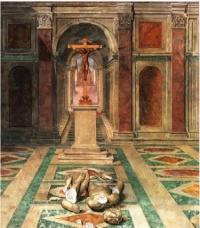Religious persecution in the Roman Empire
From The Art and Popular Culture Encyclopedia

|
Related e |
|
Featured: |
As the Roman Republic, and later the Roman Empire, expanded, it came to include people from a variety of cultures, and religions. The worship of an ever increasing number of deities was tolerated and accepted. The government, and the Romans in general, tended to be tolerant towards most religions and cults. Some religions were banned for political reasons rather than dogmatic zeal, and other rites which involved human sacrifice were banned.
In the Christian era, when Christianity became the state church of the Roman Empire, the Church came to accept it was the Emperor's duty to use secular power to enforce religious unity. Anyone within the church who did not subscribe to Catholic Christianity was seen as a threat to the dominance and purity of the "one true faith" and they saw it as their right to defend this by all means at their disposal. This led to persecution of pagans by the Christian authorities and populace after its institution as the state religion.
See also

